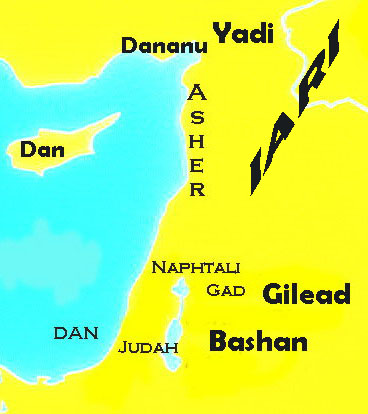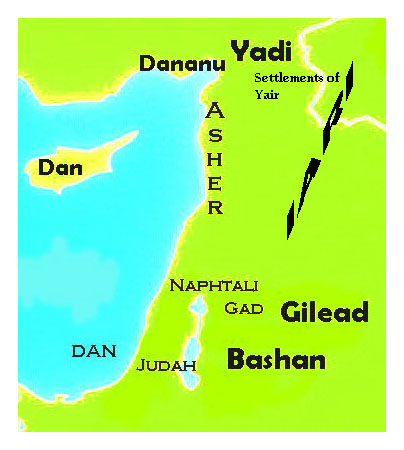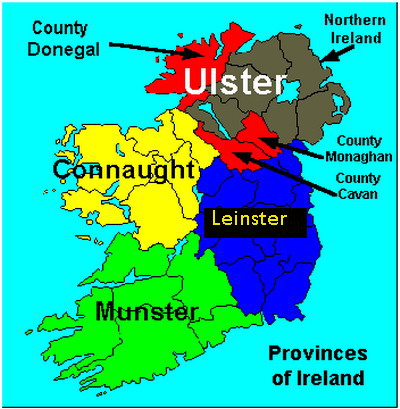The Identity of Iar (Yair) Clarified (19 August, 2014, 23 Av, 5774)
Biblical and Archaeological sources show that in the area of Israelite Tribes east of the Jordan (Gilead and Bashan) once existed Hebrew ethnic groups and polities. These groupings re-appear in similar alignments amongst the settlers of Ireland. They were from the Lost Ten Tribes.
Duration: 24.01 minutes. To Read Article Please Scroll Down
Contents:
1. Judah and Yair in Ireland
2. Yair in Scripture
3. Records of Descendants of Yair [Iari] in Mesopotamian Inscriptions
4. Disappearance and Reappearance of the Iari in Yadi. The House of Geber.
5. The House of Geber and Yair
6. Dan in the North.
7. The Invasions of Ireland
8. The People of Dan or Judah?
9. Descendants of Geber amongst the Western Celts
10. Judah and Israel in Osraige, Ireland
11. An Element from Gad?
===============================
===============================
1. Judah and Yair in Ireland
The Ten Tribes of Israel reached the shores of Western Europe and the British Isles including Ireland.
There was a tradition, recorded by William Camden, that Calcol of Judah settled in Ulster.
The IRISH attributed their attachment to the harp to their being descended from King David.
Amongst the ancestral figures of Ireland as recalled in Mythology and toponomy we find Iar.
This name may be rendered as Iarbonel, Iarbanel, Iar, and Jaruanell.
The IERN (Iverni, Iberni, Erainn) and Osraighe in southwest Ireland regarded IAR as their forefather. The Iern were related to the Ulaid and Darini of Ulster. At one stage there was a kingdom of Iern in Ulster [David Hughes]. The name, Iar, pertaining to an ancestral figure is also found in Scotland as noticed by Henri Hubert, a foremost historian of the Celtic peoples.
Ogham inscriptions recall:
The historical sept [i.e. "Tribe" after the Hebrew word "shevet"] of the Ui Maicc Iair ("grandsons of the son of Iar") and the MAQI IARI [Sons of Iari].
Keating ("THE HISTORY OF IRELAND FROM THE EARLIEST PERIOD TO THE ENGLISH INVASION" by Rev. Geoffrey Keating (ca.1570-1646), calls Iar, the son of Nemh. Nemh means "Sanctified, Separated", the same as the Hebrew "Peresh". Peresh was a son of Machir the son of Menasseh and identified with Gilead (1-Chronicles 7:16-17). Gilead was the great-grandson of Manasseh.
Keating says that Iar son of Nemha was also known as Caei the Eloquent and he was from Judah.
We thus see a possible identification Iar with both Gilead and Judah.
===============================
===============================
2. Yair in Scripture
Iar of Irish tradition parallels Yair son of Manasseh in the Bible.
Yair is recalled several times:
(1) Yair (Jair) son of Manasseh in Gilead (Numbers 32:41).
(2) Yair of Manasseh, in Bashan (Deuteronomy 3:14).
(3) Yair in the Territory of half-Manasseh (east of the Jordan) in Bashan. Implied as pertaining to Machir son of Manasseh
(Joshua 13:30).
(4) Yair the Gileadite (Judges 13:3-5).
(5) Yair son of Segub son of Hezron of Judah, in Gilead pertaining to Machir (1-Chronicles 2:22).
The above sources associate Yair with a group of settlements in Gilead or Bashan.
The areas of Gilead and Bashan were both east of the Jordan. They may have overlapped to some degree but in principle Gilead was more to the north of Bashan. Both regions stretched at an angle on an axis from the southwest to the north and northeast.
Yair is considered a descendant of Manasseh through Machir and Gilead.
In 1-Chronicles 2:22 Yair is described as a descendant of Judah through his father and of Machir of Mannasseh by his mother.
Yair in the Bible is the name given to several different personalities and to groups of settlements in Bashan and Gilead. There was some connection to Judah as well as to Manasseh and Gilead. Later there was also a close association with a group from Dan.
Iar in most Irish accounts is linked to Nial and the Milesians but in one version his lineage is attributed to the People of Dana from the Tribe of Dan.
===============================
===============================
3. Records of Descendants of Yair [Iari] in Mesopotamian Inscriptions

The name Yair in the dialect of Northern Israel and of Phoenecia would have been pronounced as Iar. Descendants of Yair are identified with the people known as the Iari who were prominent in ancient times in the area east of the Jordan and in Northern Syria. Early Assyrian inscriptions often recall the Iari who fought along the Euphrates' banks and in the north to the east of the Euphrates in the region of the Habor tributary. The Israelite territories of Gilead and Bashan did reach up to those regions.
===============================
===============================
4. Disappearance and Reappearance of the Iari in Yadi. The House of Geber.

The Iari were recorded in the north and in the Habor region in the ca. 1000s BCE.
Later they seem to have disappeared from that area.
BUT in the 700s BCE in the neighboring area of Cilicia a bit to the west we find the Land of Yadi.
[Cilicia is in northern Syria-southeast Turkey to the west of the Euphrates. The Iari had been found along both the west and eastern banks of the Upper Euphrates up to Habor.]
The name Yadi in Assyrian meant Judah.
This enclave of Judah is referred to in Scripture.
King Jeroboam-2 (NOT Jeroboam son of Nebat but a later king, Jeroboam son of Joash) was a mighty leader of the Ten Tribes. He regained territory that had once belonged to Israel but had been lost.
This included "Hamath, which belonged to Judah".
2 Kings 14:28
Now the rest of the acts of Jeroboam, and all that he did, and his might, how he warred, and how he recovered Damascus, and Hamath, which belonged to Judah, for Israel, are they not written in the book of the chronicles of the kings of Israel?
Hamath in the Bible usually referred to an area rather than a city.
"Hamath, which belonged to Judah" meant the region of Yadi.
Inscriptions have been found in Yadi recording that their ruling house belonged to the House of Geber.
===============================
===============================
5. The House of Geber and Yair
There was a Family of Administrators in the time of Solomon named Geber.
Solomon appointed Geber and his son over most (or all) of Gilead and the neighboring region of Bashan up to the Euphrates and beyond (1-Kings 4:7,13,19).
Amongst the areas they ruled over we find the settlements of Yair expressly mentioned.
1-Kings 4:
13 Ben-Geber [the Son of Geber], in Ramoth-Gilead - he had the villages of Jair son of Manasseh, which are in Gilead, and he had the region of Argob, which is in Bashan, sixty great cities with walls and bronze bars.
We later find a House of Geber ruling over an enclave named Yadi (Judah) in the north just to the west of where the Iari once were. We also know that the Iari (through Yair) were once associated with Judah.
Since we do not find the Iari anywhere else at that time we may assume that they are to be identified with Yadi.
Neighboring Yadi to the west was Smal. Yadi and Smal at times had been ruled by the same rulers. They adjoined Gilead and Bashan. Yadi evidently was a settlement of the Iari.
Later, the people of Yadi are recorded by the Assyrians as being taken into exile to an area of Armenia whereto other exiles from the Ten Tribes were also taken.
The Anglo-Saxon Chronicle said that the Celts of Britain came from Armenia.
The inhabitants of both Yadi and Smal (the Dananu) made their way to Ireland.
===============================
===============================
6. Dan in the North.
The inhabitants of Smal to the west of Yadi were ruled over by the Dananu. The Dananu (also referred to as Denyen) are believed to have had their main base a little to the south in Adana. The Dananu were a colony from the Tribe of Dan. Originally Dan had received his inheritance in the south between Judah and Ephraim (Judges 2). Many of the Danites left their area in the south and went north. In Joshua ch.2 we hear of them going to Leshem (which was renamed Dan) in the Upper Galilee. Likewise in Judges chs. 18 & 19 we read of another group of Danites moving to Laish in the north. These became the Dananu of Cilicia who shared a border with Yadi.
See:
Dan and the Serpent Way.
Dan in Northern Israel, Syria, Greece, and Elsewhere.
http://hebrewnations.com/articles/tribes/dan/dan-and-the-serpent-way.html
Iar (Yair) in irish lore was to be identified with Judah in one source, with the Dana of Dan in another, and also with Nemha whose name equates Peresh of Gilead.
===============================
===============================
7. The Invasions of Ireland

Keating based much of his history on the Book of Invasions. This work lists some of the different peoples who came to Ireland.
There were Nemedians and Fomorians, followed by Fir Bolg, Tuatha De Danaan, and Milesians.
Roughly speaking,
at first there were the Nemedians.
The name Nemedians is derived from Nemh meaning sanctified and parallel to Peresh who was associated with Gilead.
One source also refers to Iar son of Nemh making him one of them.
An invasion of Fomorians wiped out most of the Nemedians apart from some who escaped to Britain and to Greece.
Then came the Fir Bolg. These were descended from those Nemedians who had fled to Greece.
The Fir Bolg were divided into the Fir Domnann (Domnu) and Fir Galioin. They divided Ireland between them into five provinces and apparently subdued the Fomorians.
Then came the Tuatha de Danaan followed by the Milesians.
===============================
===============================
8. The People of Dan or Judah?
The name Tuatha de Danaan means "People of the godd[ess] Dana".
Dana is another way of pronouncing the name Dan and they were from Dan of Israel.
[There are those who identify the Tuatha de Danaan as the Fir Domnann section of the Fir Bolg under a different name.
The Tuatha de Danaan were of high status whereas the Fir Domnann were to devolve to a lower one.]
The Tuatha de Danaan are sometimes referred to as Tuatha de or People of the god.
The term Tuatha de in the Gaelic translation of the Bible is applied to the Jews.
David Hughes has claimed that the Tuatha de Danaan have been confused with the Tuatha-de ("men of God") meaning the Jews.
The first king of the Irish Tuatha -de was Ion son of Kari. Hughes identifies King Ion son of Kari with Johonan son of Kareah, a cousin of King Zedekiah, who led fleeing Jews to Egypt (Jeremiah 43:5-7). From there they moved to Ireland.
See:
The British Chronicles, VOLUME 1 ONLY, Volume 1 by David Hughes, 2007, USA
The inclusion of Jews alongside the Tuatha de Danaan may seem far-fetched to us. Nevertheless, there may be something to it.
The Irish sources however usually identify Iar as a Milesian; one says he was a Dana; another that he was Jewish.
The Bible itself refers to Yair as both from Judah and from Gilead of Manasseh and historically we found the Iari in alliance with the Dananu of Dan.
The Tuatha de Danaan defeated the fir Bolg and then gave them Connacht in the west.
They struggled with the Fomorians for the rest but eventually came to an understanding and may have intermarried with them.
Then came the Milesians, also known as Gaels, and Hiberni, and conquered them all. Iar seems under different variations of his name to have been identified with them all.
===============================
===============================
9. Descendants of Geber amongst the Western Celts
We saw how the family of administrators of Geber had been placed by Solomon over most Israelte lands east of the Jordan. Later we found the House of Geber ruling over Yadi whioch may have represented a remnaned of Gilead and of the settlements of Yair, the Iari of Assyrian records.
They were exiled by Assyria and moved to the west.
Their name is recalled in the GABRETA in Bavaria and the city of Gabromagus and Vergobretus (in territory of the Aedui of Gaul, Caesar, G.W.1;1. So too, the Guberni (Pliny N.H.4;17) were between the Ubii and Batavi in Holland.
The Gabraige and Gabran were in southeast Ireland. A king of the Picts in northern Scotland was also called Gabran.
The Lagin people were also known as GABAIR. They gave their name to Leinster in east Ireland. To the northeast of Eboracum (York) and the Parissi in Britain were the GABRANTOVICES. The Parissi were named after Peresh of Gilead in Manasseh. Further north in the Caledonian region (of Scotland) of the Gadeni (Otadeni) was the settlement of Gabrosentas.
Associated with the Gabair of Leinster were the Fir Domnan (Dumnonii). There was also a region of the Dumnoni in Devon and the surrounding area of southwest Britain which was also known as Dannonia linking it to Dan.
Leinster in East Ireland was eventually dominated by the Viking Danes (from Denmark) who were also from Dan.
Through the Biblical figure of Yair and the settlements named after him we found associations with Judah, Gilead, and Dan, and the Ruling administrative Dynasty of Geber. We found this pattern repeated in the west, especially in Ireland.
See Also:
===============================
===============================
10. Judah and Israel in Osraige, Ireland
Stephen Phillips brought to our intention the Osraige (pronounced Osray) who were to be found in Southern Ireland between Munster and Leinster. It gave rise to The Kingdom of Ossory that played an important role in the later history of Ireland. The name Osraige (as Stephen Phillips points out) is a variation on the name Easru which in turn is a corruption of the name Israel. Ptolemy places the Ouodiai (meaning Judah) where the Osraige should be. We thus have a contingent of Judah and Israel corresponding to the IARI in the Middle East.
===============================
===============================
11. An Element from Gad?
Wikipedia tells us that the Osraighe claimed to be descended from the Erainn whom we saw were also from the IARI of Yair.
We traced Yadi in the Middle East to the Iari and to Judah. They bordered the area of Smal which at times was ruled over by the Dananu (from Dan) to their south. Elsewhere we have traced Smal to the clan of Tsifion of Gad (Genesis 46:15, written as Tsefon in Numbers 26:15).
It is interesting to note that in north of Osraige were the Brigantes while to the south were the Cauci. O'Rahilly believed that the Brigantes were from the Erain. Brigantes were also recorded in Yorkshire (north England) and Switzerland. In The Tribes we traced the Brigantes to Beriah of Asher (Genesis 46:17) and/or Ephraim (1-Chronicles 7:23). New evidence suggests that Gad may also be a possibility, re.
Britain Key to World History by Comyns Beaumont (Reprinted Britain 2011) tells us:
In their own annals they [the Brigantes of Britain] claimed to be originally descended from the tribe of Gad,
This claim is commemorated in a bardic poem of Caedmon, the Brigantine poet,
entitled, "I sing of the origin of the Gadalians," in which he claimed that Breoganus, descended
from Gad, founded Brigantia in "Spain" and that his posterity sailed for Ireland. Chas. Squire
(in Myths of the British Islands) says that "Spain" in ancient traditions was often a synonym
for the Celtic Underworld, but on the authority of Ortelius, the Brigantes were certainly also
settled in Waterford and Kilkenny [Ireland].
The Cauci were also to be found as Chauci in what is now the Netherlands. They descended from Haggi (Chaggi) of Gad.

